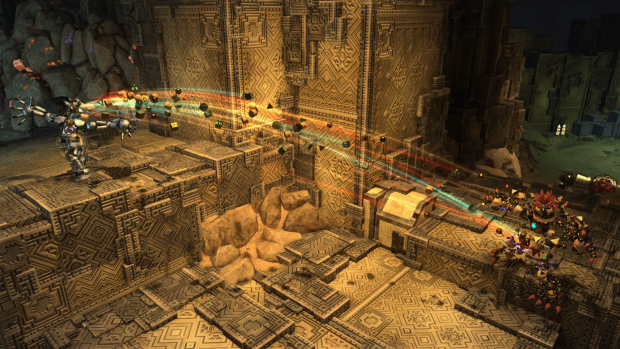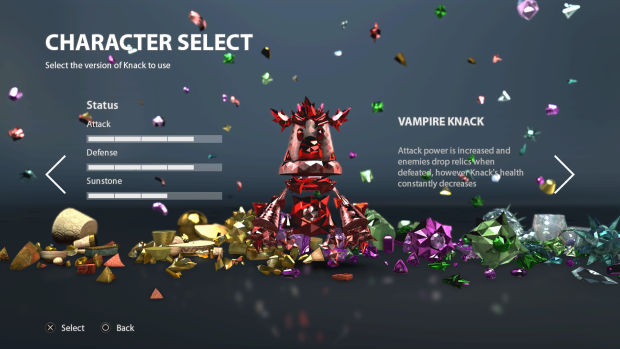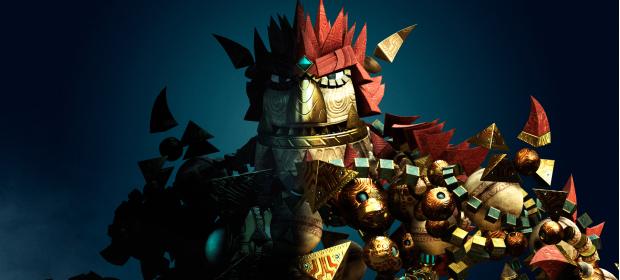Forget everything you thought you knew about Knack. This isn’t a cutesy kids game. It’s not really a platform game, either. In fact, the closest comparison I can make for Sony’s new IP and launch PS4 game is Dark Souls.
Now bare with me here. Knack’s difficulty is punishing, and each area feels like a mini-stage that requires the utmost concentration – something that, perhaps, the modern gamer isn’t used to giving. There are multiple enemies that can one-hit kill Knack, and even more that can remove half his health bar in one hit. Boss battles don’t have checkpoints, so you’ll have to attack them and complete them in one life. Knack takes no prisoners.
But this difficulty yields rewards, and also creates problems. On one hand, the first proper boss (towards the end of chapter 3) does indeed require you to tackle him in one go, with one health bar, or you have to start again. The checkpointing is infuriating. Despite the difficulty, even upon accepting it, you’ll get angry at how far back you have to go due to a stupid mistake. The issue that confounds things is that you’ll almost always die when a new enemy is introduced, because you don’t yet know his attack pattern and therefore it’s back to the start of the level, or back to the long-past checkpoint for you. That’s punishing, but on another level.

Knack controls very well, and can double-jump, dash (on the right stick) to avoid heavy attacks, and generally move around the slightly sparse environments with ease. A Golem, Knack can find (and is made up of) relics scattered around the levels and when he does, he grows. Some levels will see you grow to huge proportions, and although at first it appears the difficulty eases off, in fact, it’s an opportunity to include new enemies that match your strength.
When he’s small, Knack is nimble but weak, with a tiny sliver of a health bar. All grown up, he’s powerful, strong, but slow and less effective when dashing. The trade-off is health and power versus pace and agility, but you are never really given the choice as to which Knack you play as; instead the level progresses from small to big in a natural manner and you are shuffled along with it. There are certain levels that allow you to be ice-Knack, or stealth-Knack (he can absorb different materials after a certain amount of the story is unravelled), but these are also confined to specific levels – though you can unlock alternative “suits” for Knack that allow you to replay the game in different manners.
The story is predictable. Knack is the creation of a professor, whose young prodigy immediately bonds with the titular Golem. There’s a villain who isn’t cast until a few chapters in, but you’ve already telegraphed it from a mile away. It looks like a Disney Pixar movie, and has a voice cast to match. In fact, the only oddity is the fact that Knack himself is fully voiced. Startling at first, despite his cutesy appearance, he actually sounds more like the late Michael Clarke Duncan, which works when he’s big but is jarring when little.

But it’s visually splendid, and it’s lovely to see a launch title (or any title, for that matter) so full of vibrant colours and charm. There are rare moments of slowdown, but the biggest problem with how Knack looks is that these stunning environments are pretty empty. Each new screen will have a set number of enemies and a way in or out, a possible secret area that hides a collectible or health/magic power-up, and that’s it. Once you’ve defeated the enemies in the area, it’ll allow you to leave and you can repeat it from level to level.
There’s a nice variation in locations: some levels you’ll be visiting the goblins’ homes, yet others you’ll be in a residential palace fighting your way through corridors. There’s just always a nagging feeling that something is missing. Breaking from the beaten path to find a collectible (you build components that aid gameplay, like an object that allows more magic, or one that reveals hidden areas) is a reward, but also shines light on how linear the game is.
Moment-to-moment gaming is enjoyable, if difficult, and there are plenty of enemy variations. In fact, going back to the Dark Souls comparison – each enemy has a tell. It might be a ranged enemy that pauses briefly to reload after his second barrage of attacks, or a larger goblin that swings twice instead of four times. The platforming is simple, but also presents an odd issue. Most of the time the platforms will require a double jump, being ever so slightly too tall for a single jump to be enough. This stood out to me, as I couldn’t work out why the platform – a simple rocky crag, for example – wasn’t made slightly smaller, or the single jump height made slightly higher.

A lengthy campaign is on offer here, which is also something that goes against Knack a little. While the enemies themselves make up the variation, the combat itself is simplistic. A three-hit combo is about all you get, aside from a jumping attack. Three special moves (including a ranged attack that can be invaluable) make up the rest of the arsenal, but collecting magic for them takes a while, so you’ll want to reserve them for especially hard sections – they feel like get out of jail cards at times.
Local co-op is available if you do fancy changing things up. The second player controls robo-Knack and can help beat up the enemies, but can also heal Knack, which means co-op definitely eases the difficulty, and is a way to go if you’re finding things just too tough.
VERDICT: The biggest issue with Knack is that it delivers on a completely different experience than you would expect: a tricky yet rewarding old-school game brought kicking and screaming into a brand new generation was always going to confuse people. But it’s a lot of fun, and despite frustration through poor checkpointing, Knack is far from a bad game. In fact, there’s potential for this to become a cult favourite among gamers. It looks like a family-friendly game, but this one is aimed at the hardcore players, and when you consider it’s a new IP for a new console, that’s kind of brave.

GOOD. A game that scores 7/10 is worthy of note, but unworthy of fanfare. It does many things well, but only a few of them incredibly well and, despite a handful of good qualities, fresh ideas and solid mechanics, it fails to overwhelm.
Review copy provided by publisher.





